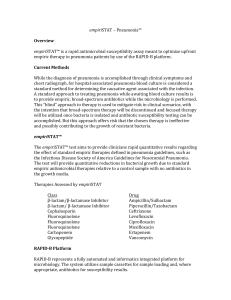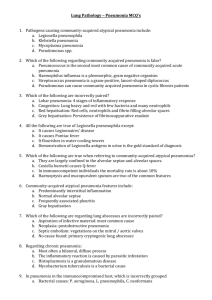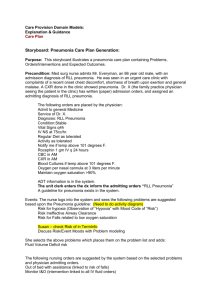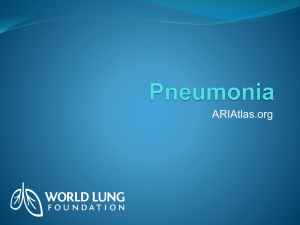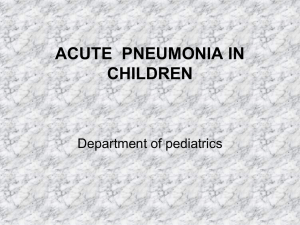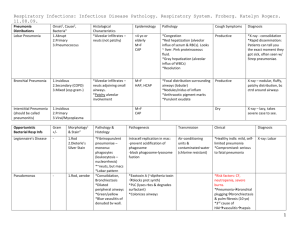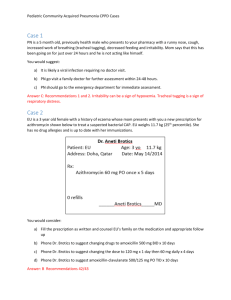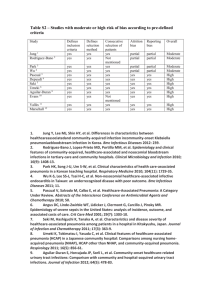Key Messages Pneumonia is the #1 killer of children under age 5
advertisement
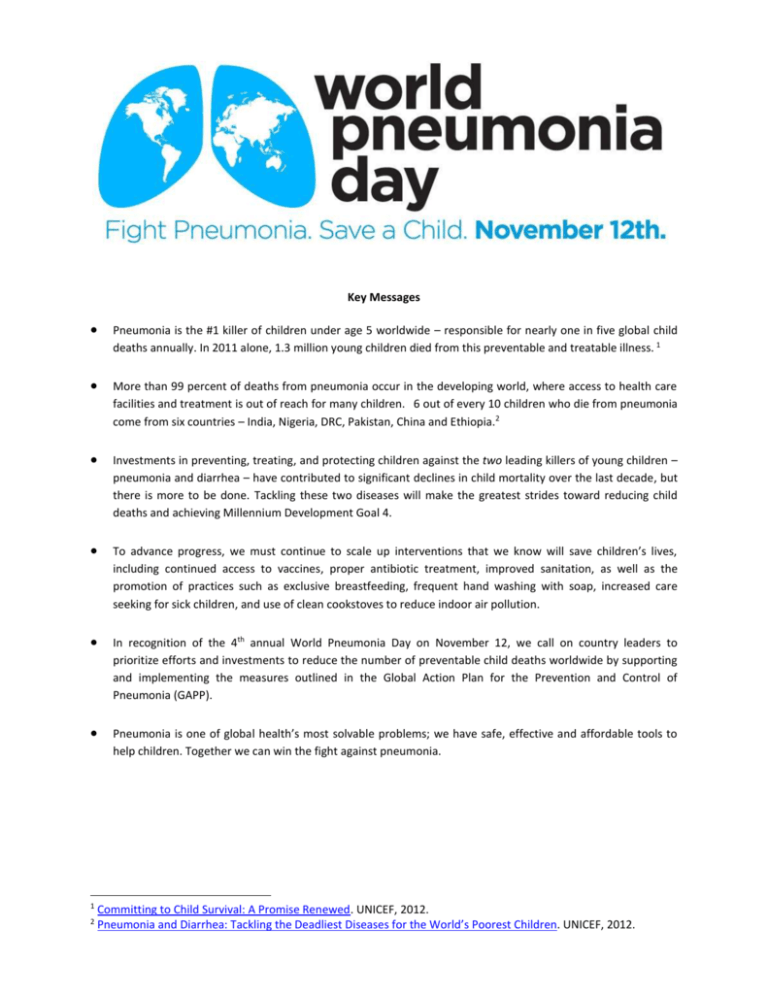
Key Messages Pneumonia is the #1 killer of children under age 5 worldwide – responsible for nearly one in five global child deaths annually. In 2011 alone, 1.3 million young children died from this preventable and treatable illness. 1 More than 99 percent of deaths from pneumonia occur in the developing world, where access to health care facilities and treatment is out of reach for many children. 6 out of every 10 children who die from pneumonia come from six countries – India, Nigeria, DRC, Pakistan, China and Ethiopia.2 Investments in preventing, treating, and protecting children against the two leading killers of young children – pneumonia and diarrhea – have contributed to significant declines in child mortality over the last decade, but there is more to be done. Tackling these two diseases will make the greatest strides toward reducing child deaths and achieving Millennium Development Goal 4. To advance progress, we must continue to scale up interventions that we know will save children’s lives, including continued access to vaccines, proper antibiotic treatment, improved sanitation, as well as the promotion of practices such as exclusive breastfeeding, frequent hand washing with soap, increased care seeking for sick children, and use of clean cookstoves to reduce indoor air pollution. In recognition of the 4th annual World Pneumonia Day on November 12, we call on country leaders to prioritize efforts and investments to reduce the number of preventable child deaths worldwide by supporting and implementing the measures outlined in the Global Action Plan for the Prevention and Control of Pneumonia (GAPP). Pneumonia is one of global health’s most solvable problems; we have safe, effective and affordable tools to help children. Together we can win the fight against pneumonia. 1 2 Committing to Child Survival: A Promise Renewed. UNICEF, 2012. Pneumonia and Diarrhea: Tackling the Deadliest Diseases for the World’s Poorest Children. UNICEF, 2012. About World Pneumonia Day In 2009, the World Health Organization and UNICEF released the Global Action Plan for the Prevention and Control of Pneumonia (GAPP) showing that pneumonia deaths could be reduced by two-thirds if existing interventions to protect against, prevent and treat pneumonia could be scaled up to reach 90 percent of the world’s children. Concurrent with the release of GAPP, a diverse group of advocacy, academic and service organizations joined forces to form the Global Coalition Against Child Pneumonia. Working together, the Coalition launched the first ever World Pneumonia Day in 2009 –observed annually on November 12- to: Raise awareness about pneumonia, the world’s leading killer of children under the age of five; Promote interventions to protect against, prevent and treat pneumonia; and Generate action to combat pneumonia. Since its inception, World Pneumonia Day has earned international recognition among health leaders, medical professionals, journalists, activists and community leaders as the day for the world to collectively raise its voice and take action on behalf of the millions of children who die from this preventable illness every year. The Global Coalition Against Child Pneumonia World Pneumonia Day is led by a committed and diverse group of over 140 NGOS, community based organizations, academic institutions, government agencies and foundations working together as the Global Coalition Against Child Pneumonia. Every week, new organizations reach out to be a part of this important work. If you would like to join The Global Coalition please email Kathryn Graczyk at kgraczyk@jhsph.edu. We welcome your involvement! For more information about the Global Coalition Against Child Pneumonia and World Pneumonia Day, please visit: www.worldpneumoniaday.org. Pneumonia Q&A 1. What is pneumonia? Pneumonia is a severe acute lower respiratory infection that specifically affects the lungs. Pus and fluid fill the alveoli, the smallest air spaces in the lungs, and make it difficult to absorb oxygen. 2. What are the clinical symptoms of pneumonia? Cough, fast breathing and/or fever are often the presenting symptoms of pneumonia. Severe pneumonia causes difficulty breathing, which may manifest in children under 5 years as chest indrawing, grunting or nasal flaring (in young infants). A child with very severe pneumonia may also appear lethargic, unconscious or have central cyanosis and be unable to eat or drink. 3. What causes pneumonia? Pneumonia is caused by some kinds of bacteria, viruses and fungi. Bacteria are more likely to result in severe pneumonia, with Streptococcus pneumoniae (pneumococcus) being the leading cause of severe pneumonia among children in the developing world. Vaccine studies using the pneumococcal conjugate vaccine indicate that up to 37-39% of pneumonia cases in children are caused by pneumococcus. Haemophilus influenzae type b (Hib) is also another common bacterial cause of pneumonia. Recent studies published in the Lancet reported that pneumococcus and Hib are responsible for the majority of child pneumonia deaths every year. Viruses such as respiratory synctial virus (RSV) and influenzae are also important causes of pneumonia. The fungus Pneumocystis jiroveci (PCP) is important in persons with AIDS. 4. How are bacterial pneumonias different from viral pneumonias? There is no easy way of distinguishing bacterial and viral causes of pneumonia because there is large overlap in common presenting clinical symptoms. Bacterial pneumonias usually result in children becoming severely ill with high fever and rapid breathing; while viral pneumonias generally start more gradually and worsen over time. An Xray that shows a lobar consolidation is usually attributed to a bacterial cause of pneumonia. 5. Who is most at risk for acquiring pneumonia? Children with compromised immune systems are at greater risk for acquiring pneumonia. For example, undernourished children, low birth weight infants, infants who are not breastfed and children suffering from other illnesses such as AIDS are more likely to develop pneumonia. Environmental factors also increase the risk for pneumonia: overcrowding in homes and exposure to tobacco smoke or indoor air pollution can make children more susceptible to pneumonia. 6. How is pneumonia diagnosed? Pneumonia is diagnosed most often by the combination of presenting clinical symptoms. A chest X-ray can help confirm the diagnosis since a chest X-ray should be abnormal in the case of pneumonia. A lobar consolidation is the classical presentation of a bacterial pneumonia, however, sometimes viral pneumonias can also result in lobar consolidation. A blood culture may help determine the exact cause of a bacterial pneumonia but is only positive in less than 10% of patients with a clinical diagnosis of pneumonia. 7. How is pneumonia treated? Pneumonia is treated with a prompt, appropriate course of antibiotics. The type of antibiotic, route of administration and duration of therapy depend on the age of the patient, the severity of the pneumonia and local patterns of antimicrobial resistance. Cotrimoxazole and amoxicillin are usually effective drugs against the common bacteria causing pneumonia and WHO recommends amoxicillin in dispersible tablet form as the firstline treatment for child pneumonia in developing countries. Infants under two months are at risk of severe illness and death, and so they should be referred to a hospital for treatment with intravenous antibiotics. Where antibiotic resistance rates are high, the first-line drugs may be less effective against pneumonia and alternative drugs may be needed. In some settings, where there are large numbers of high-risk persons who are undernourished or HIV-positive, treatment strategies need to be adapted to use drugs that are effective against PCP. 8. How dangerous is pneumonia? About 1 in 5 child deaths under 5 years of age worldwide is due to pneumonia. Pneumonia is the most common killer of children: it kills more children then AIDS, malaria and measles combined. Almost all child deaths occur in the developing world where vaccines and antibiotics are not widely available. A majority of child pneumonia deaths occur in just six countries – India, Nigeria, Democratic Republic of Congo, Pakistan, China and Ethiopia. 9. How can pneumonia be prevented? Preventing pneumonia is key to improving child survival. Preventing under nutrition in children can reduce their risk of acquiring pneumonia or dying from pneumonia. Breastfeeding infants and providing zinc supplementation for children have been proven to reduce the risk of pneumonia and death. There are also well-tolerated, effective vaccines against the common bacterial causes of pneumonia: the pneumococcal conjugate vaccine and the Hib vaccine. The routine use of these vaccines can significantly reduce the burden of illness and death due to pneumonia. Hand washing with soap and reducing indoor air pollution are also critical to preventing child pneumonia. 10. Why are 1.3 million children dying from an infection that is preventable and treatable? Currently very few of the world’s poorest countries routinely vaccinate children against pneumococcal and Hib disease, and few children with pneumonia receive appropriate antibiotic therapy in developing countries. For many countries, the anti-pneumonia vaccines are too expensive to introduce and when children become ill with pneumonia only half are taken to an appropriate provider, largely because too few caregivers correctly recognize the symptoms of pneumonia which result in critical delays in seeking care for sick children. Results from limited data suggest that just 1 in 5 child with pneumonia ever receive antibiotics. Reducing pneumonia deaths among children will require dramatic improvements in vaccination coverage, awareness among caregivers and timely care seeking and antibiotic use. Increased nutrition including breastfeeding, hand washing with soap and reductions in indoor air pollution will also reduce the spread of infections and child deaths. Please see www.worldpneumoniaday.org for more information.

